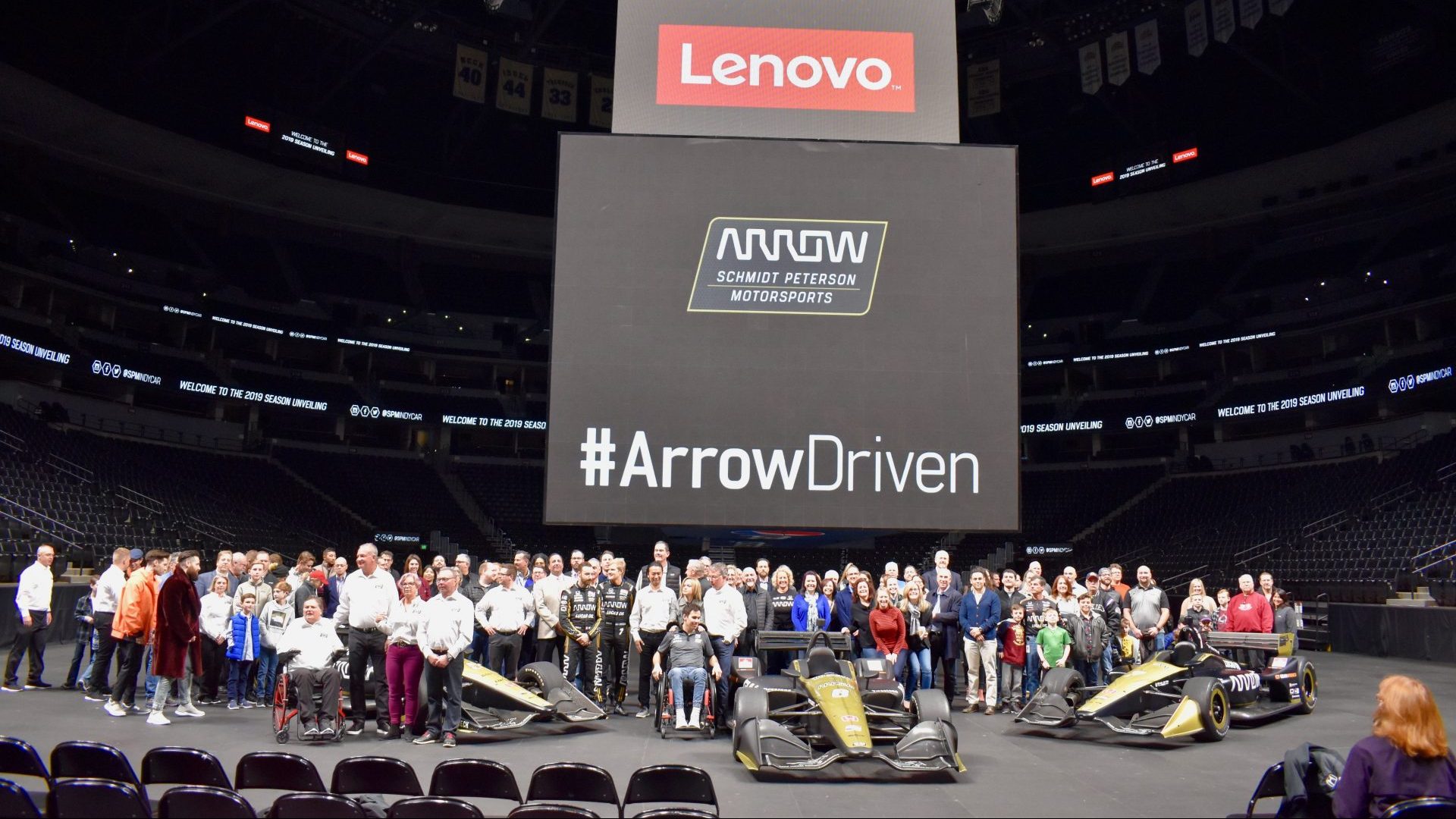

IndyCar team Schmidt Peterson Motorsports announced Friday at its 2019 livery reveal in Denver, Colorado that it has formed a multi-year partnership with Arrow Electronics. With Arrow Electronics as a title partner, the team’s official name now becomes Arrow Schmidt Peterson Motorsports.

ASPM was founded by Sam Schmidt as an Indy Lights team following an IndyCar crash that left Schmidt quadriplegic. The team went on to become the winningest Indy Lights team in history and has since moved up to IndyCar itself, where it has collected seven race wins, along with the 2011 Indianapolis 500 pole position.
Schmidt himself missed driving, and in 2013, he collaborated with Arrow Electronics to develop a system that would allow him to safely control a vehicle again. Arrow devised a system that used four infrared cameras to track Schmidt’s head for steering control, and a pressure sensor connected via tube to Schmidt’s mouth, where he could blow to go, and suck to stop. This system was integrated into a Chevrolet Corvette, which was renamed the Semi-Autonomous Motorcar, or SAM. Schmidt first captained the car on May 18, 2014 at the Indianapolis Motor Speedway, driving the car up to 97 miles per hour in his first outing, and 107 in his second, a week later.
In 2016, Schmidt proved the system’s merit twofold, first by racing the bottom half of the course at the 2016 Pikes Peak International Hill Climb, second by competing in the iRacing Pro Race of Champions, in which he finished 16th of 25—beating out professionals with full use of their bodies. Schmidt and his car satisfied the Nevada Department of Motor Vehicles, which gave Schmidt the first license to operate a semi-autonomous vehicle in the United States.
“For me, this announcement is nothing short of a lifelong dream come true,” Schmidt said of his team’s partnership with Arrow. “Mike Long and the entire team at Arrow first had vision to create a system that enabled me to get behind the wheel after 16 years of paralysis which, in and of itself, has changed my life and the lives of millions worldwide. Now, by becoming our team title partner, they have given us the resources to fulfill another lifelong dream to win the Indy 500 and a championship in the IndyCar Series.”
He confirmed at the event that the Arrow partnership would be a “long-term” deal, and that considers Arrow’s contribution something to help the team draw talent—drivers especially—in the future.
“With this new announcement, we don’t have to experiment, we don’t have to gamble on rookies,” Schmidt told The Drive. “We can go get people that we know
have the results.”

One such driver is displaced Formula 1 driver Marcus Ericsson, who will race for the team alongside veteran James Hinchcliffe at ASPM in 2019. As good a catch as Schmidt considers Ericsson, he isn’t expecting as miraculous a performance as that of Robert Wickens, who wowed in his rookie year at SPM before a crash at Pocono Raceway that resulted in a spinal injury sidelined him.
“It’ll inevitably take Marcus a little bit of time to learn the tracks, learn the car, get integrated,” Schmidt cautioned. “What Robert did last year was so phenomenal, I would not have as high of expectations, but hopefully something close. Hinch is now, you know, the senior guy here, so hopefully he can use his experience and the new resources to go win some races.”

Ericsson remains a reserve driver for Alfa Romeo Sauber F1 Team and may need to miss a race in IndyCar in the unlikely situation that he is called back to F1. Schmidt has not yet determined who would fill Ericsson’s cockpit in that contingency.
“Obviously, you need to see where everybody else lands,” Schmidt said of a backup for Ericsson. “I mean we’ve got a short list, but there’s a pretty strong likelihood he wouldn’t go back full-time. It’s a good situation to have somebody that’s still doing [F1] simulation and operating at that high of a level helping us.”

The Swede got his opportunity at ASPM due to the aforementioned crash of Wickens, which changed Schmidt’s relationship with the driver.
“Unfortunately, I’m probably the best guy in the paddock to help him through it,” Schmidt said of Wickens’ recovery, having experienced spinal injuries himself. “Changed from being a driver coach to being this coach. He’s got a lot of drive, a lot of determination, and the things that made him successful as a race car driver will maximize his recovery.”
A solution to prevent further accidents as catastrophic as Wickens’ was proposed by Schmidt in August of last year: double the height of SAFER barriers in key points along the track, provided spectators’ views are unaffected.
“IndyCar is being very aggressive in trying to find a solution. Mikhail [Aleshin]’s accident and his [Wickens’] accident, I feel in the short term, the SAFER barrier has proven to do a good job, there are a lot of places we can sorta double-height that, and solve a problem. I haven’t talked to a lot of track owners, mainly talked to IndyCar, really they’re the ones that have to make the request, the demand. Jay Frye’s got a committee, and they’re working on things they can do better.”